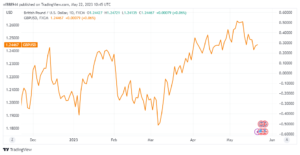After a tranquil Asian session on Monday, the GBPUSD has lost traction and begun to fall in the European morning. The pair is facing heavy resistance around the 1.2450/60 zone, and sellers may maintain control if GBPUSD fails to convert that sector into support.
Despite broad-based US Dollar (USD) gain, GBPUSD ended the previous week nearly unchanged, thanks to Friday’s comeback.
Although investors remain confident that the US Federal Reserve (Fed) will maintain its policy rate in June, market positioning implies that they may reconsider the potential of a rate drop later in the year. Markets are presently putting in a nearly 60% chance that the Fed’s policy rate will remain unchanged, according to the CME Group Fed Watch Tool. Its current September range of 5-5.25%, compared to barely 30% previous week.
Richmond Fed President Thomas Barkin, Atlanta Fed President Raphael Bostic, and San Francisco Fed President Mary Daly will speak later in the day. Even if Fed policymakers affirm a pause in June, the US Dollar’s losses are expected to be limited in the short term since investors are more concerned with how policy will look at the end of the year.
Meanwhile, the FTSE 100 Index in the United Kingdom is up 0.3% in early European morning trading, while US stock index futures are largely flat. If risk flows resume in the second half of the day, the USD may lose strength, allowing the GBPUSD to recoup.
Nonetheless, it is worth noting that investors may refrain from favoring risky assets unless there are favorable improvements in the debt limit discussions. According to reports, US President Joe Biden and House Republican Speaker Kevin McCarthy will speak again later in the day.
GBPUSD Technical Outlook
In the 1.2450/60 level, the descending trend line, the Fibonacci 23.6% retracement of the most recent upswing, and the 20-period Simple Moving Average (SMA) constitute significant resistance.

If GBPUSD breaks over that barrier and begins to use it as support, it might continue its rally to 1.2480 (200-period SMA), 1.2500 (psychological level), and 1.2530 (100-period SMA).
On the downside, 1.2400 (psychological level, static level) is an important support level, followed by 1.2360 (static level) and 1.2330 (Fibonacci 38.2% retracement).









